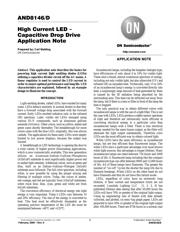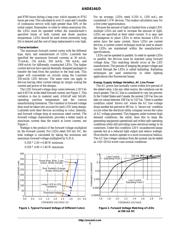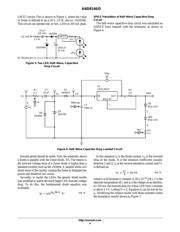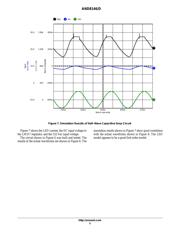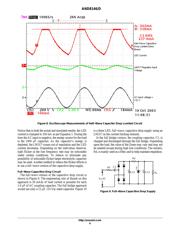Datasheet 搜索 > 稳压芯片 > ON Semiconductor(安森美) > LM317BTG 数据手册 > LM317BTG 开发手册 1/14 页
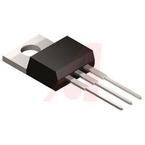
¥ 5.29
LM317BTG 开发手册 - ON Semiconductor(安森美)
制造商:
ON Semiconductor(安森美)
分类:
稳压芯片
封装:
TO-220-3
描述:
LM317 线性稳压器,ON Semiconductor**ON Semiconductor LM317** 系列是可调线性稳压器。 3 端子正电压稳压器可提供 1.5A 及更高的输出电流,输出电压介于 1.2 至 37V 之间。 易于使用的 LM317 可调稳压器可用于各种应用,如卡式调节,并可用作可编程输出稳压器;通过在调整和输出之间连接一个固定电阻器,它可用作精密电流稳压器。 输出电压范围:1.25 V 至 37 V 输出电流:1.5 A 短路电流限制、热保护和安全区域补偿 浮动操作,用于高电压应用 ### 线性稳压器,On Semiconductor
Pictures:
3D模型
符号图
焊盘图
引脚图
产品图
页面导航:
原理图在P7
型号编码规则在P14
导航目录
LM317BTG数据手册
Page:
of 14 Go
若手册格式错乱,请下载阅览PDF原文件

Semiconductor Components Industries, LLC, 2004
February, 2004 − Rev. 0
1 Publication Order Number:
AND8146/D
AND8146/D
High Current LED −
Capacitive Drop Drive
Application Note
Prepared by: Carl Walding
ON Semiconductor
Abstract. This application note describes the basics for
powering high current light emitting diodes (LEDs)
utilizing a capacitive divider circuit off the AC mains. A
linear regulator is used to control the LED current in
order to ensure optimal performance and long life. LED
characteristics are explained, followed by an example
design to illustrate the concept.
INTRODUCTION
Light emitting diodes, called LEDs, have existed for many
years. LEDs behave similarly to normal diodes in that they
have a forward voltage drop associated with the forward
current. Early LEDs emitted radiation only in the infrared
(IR) spectrum. Later, visible red LEDs emerged using
various III−V compounds, such as aluminum gallium
arsenide (AlGaAs). Other colors, such as yellow, amber and
green came shortly thereafter. The breakthrough for more
colors came with the blue LED; originally, this was silicon
carbide. The applications for these early LEDs were largely
limited to low power displays, because the output was
limited.
A breakthrough in LED technology is opening the door to
a wide variety of higher power illuminating applications,
which is now commercially available. This new generation
utilizes an Aluminum−Indium−Gallium−Phosphorus
(AlInGaP) substrate to emit significantly higher power red
or amber light intensity. Additional colors, such as green and
blue, built on an Indium−Gallium−Nitrogen (InGaN)
substrate soon followed. The full color spectrum, including
white, is now possible by using the proper mixing and
filtering of multiple colors. Today, the colors of amber,
red−orange, and red are typically from AlInGaP substrates,
while royal blue, blue, cyan, green and white are from
InGaN substrates.
The conversion efficiency of electrical energy into light
energy is very important. Today’s LEDs vary between 10
and 20% efficiency. The rest of the energy is converted to
heat. This heat must be effectively dissipated, as the
operating junction temperature of the LED die must be
maintained between −40°C and +125°C.
Incandescent lamps, including the tungsten−halogen type,
have efficiencies of only about 4 to 10% for visible light.
These emit a broad, almost continuous spectrum of energy,
including not only visible light, but also ultraviolet (UV) and
infrared (IR) as unusable heat. Technically, only 15 to 20%
of an incandescent lamp’s energy is converted directly into
heat; a surprisingly large amount of heat generated by them
is caused by the IR radiation being absorbed by the
surrounding area. This heat can be reflected out away from
the lamp, but if there is a lens or filter in front of the lamp the
heat is trapped.
The only practical way to obtain different colors with
incandescent lamps is with the use of a light filter. This is not
the case with LEDs. LEDs produce a rather narrow spectrum
of light and therefore are intrinsically more efficient at
converting electrical energy to a particular color than
incandescent lamps with a filter. There is less electrical
energy needed for the same lumen output, as the filter will
attenuate the light output substantially. Therefore color
LEDs are the most efficient way to obtain colored light.
White LEDs have the same efficiency as incandescent
lamps, but are less efficient than fluorescent lamps. The
white LEDs have a particular advantage over most known
white light sources; this advantage is longer lifetime. Many
incandescent lamps are rated between 750 hours and 2000
hours of life. A fluorescent lamp including like the compact
incandescent type can offer between 8000 and 12,000 hours
of life. All of these lamps have filaments. The greater the
number of “on−off ”cycles the shorter the lamp life due to
filament breakage. White LEDs on the other hand do not
have filaments and thus do not have this failure mode.
LEDs, regardless of color, have an extremely long
lifetime, if their current and temperature limits are not
exceeded. Lumileds Lighting LLC [1, 2, 3, 4] has
published lifetime data stating that after 50,000 hours the
LEDs will have 70% or greater of the original light output.
Using an engineering rule of thumb with data already
collected, and plotted, on semi−log graph paper, LEDs are
projected to have 50% or greater of the original light output
after 100,000 hours. There are 8736 hours in a normal year
APPLICATION NOTE
http://onsemi.com
器件 Datasheet 文档搜索
AiEMA 数据库涵盖高达 72,405,303 个元件的数据手册,每天更新 5,000 多个 PDF 文件

